Asteroid and comet studies
Telescopic studies of asteroids and comets continue to reveal new information about the nature of our Solar System. Click on the image for a larger view and more information.
I'm interested in most aspects of the motions of planets and other bodies around their stars. A selection of some older research is listed below, though not all have detailed information. Email me at pwiegert [@] uwo.ca for more info.
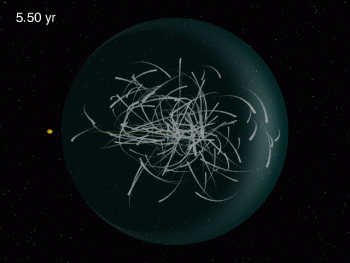
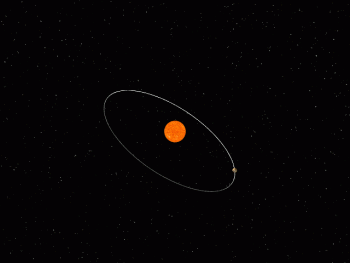

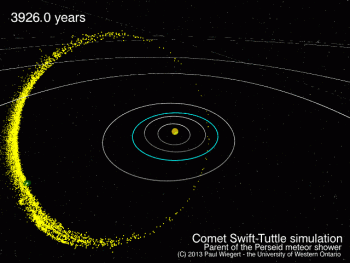
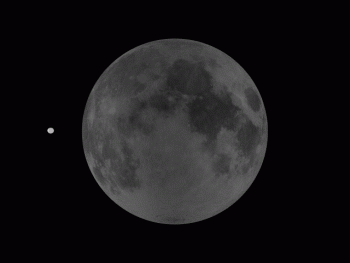
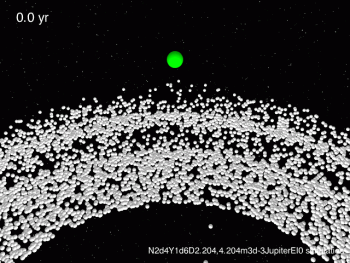
Telescopic studies of asteroids and comets continue to reveal new information about the nature of our Solar System. Click on the image for a larger view and more information.
(7-Nov-2019) Backtracking interstellar asteroids and comets to their birthplaces at one of the 100 billion stars in our Milky Way galaxy requires bridging the fields of solar system and galactic dynamics. Click on the animation at the left for more information, and for larger animated fly-throughs of our Galaxy by recent interstellar visitors.
(10-Jun-2019) In June 2019 the Earth will pass near to the centre of the hypothesized Taurid resonant asteroid swarm. This will be the best viewing geometry to detect and place limits on the number of asteroids proposed to reside at the swarm centre until the early 2030s. We present an analysis of the optimal times and pointing locations to image near-Earth asteroids associated with the swarm. Click on the animation at the left for the technical article (includes more animations of the swarm) or here for the Sky and Telescope article.
(9-Oct-2018) Kepler-159b and c are exoplanets detected by NASA's Kepler planet-hunting spacecraft. Kepler-159d was discovered at Western University from its gravitational effects on 159b and c. Kepler-159d has about the mass of our planet Saturn, and orbits within the Habitable Zone of its distant (1200 light-years away) host star, but little else is known about it yet. Click on the animation, or here, for more.
(30-Mar-2017) Asteroid 2015 BZ509 is a rare retrograde asteroid, that is it orbits the Sun in the direction opposite that of the planets and 99.99% of the other asteroids. Stranger still, it also shares the orbital space and an important dynamical link with the giant planet Jupiter. 2015 BZ509 is a retrograde analogue of Jupiter's Trojan asteroids, and is discussed in the 30 March 2017 issue of Nature. The paper made #47 on Discover magazine's Top 100 of 2017. Click on the left movie, or here, for more.
On 14 November 2013 in the journal Nature, a team of astronomers including myself present a definitive analysis of the asteroid that burned up spectacularly over the Russian city of Chelyabinsk in February 2013. To the left you see a simulated ride on the asteroid during its final approach to our planet. Click on it for more info and a bigger view.
Canadian and French astronomers analyzed the motion of the as-yet-unnamed asteroid designated 2010 TK7, first detected by the WISE satellite, to determine that it was the first classical Trojan asteroid of the Earth. If you would like to know more about 2010 TK7 and its motion, reported in the 28 July 2011 issue of Nature, click on the movie to the left.
Debris disks are gas-poor collections of solid matter which orbit some stars. Structures in the disks can reveal the presence of nearby planets which are themselves too faint to see. For more information, you can check out my former PhD student Maryam Tabeshian's recent 2016 and 2017 Astrophysical Journal papers.
I have been involved in an a study, in collaboration with Kim Innanen (York) and Seppo Mikkola (Turku), of near-Earth asteroids. During this research, we discovered that the Earth has a companion asteroid. If you would like to know more about asteroid 3753 Cruithne, you can visit its home page here.
Most near-Earth asteroids have no consistent dynamical connection to our planet. However, those that go around the Sun in precisely the same amount of time as our planet fall into 1:1 mean-motion resonance with our planet (which just means that both go around the Sun once in the same average (mean) amount of time). These rare bodies are called Earth coorbital or companion asteroids; they in some sense share the Earth's orbit with it. With a highly circular orbit that is the most Earth-like seen so far, and able to transit between two distinct types of resonant motion, is the near-Earth asteroid designated 2002 AA29.
What goes round and round a planet but isn't (technically) a moon? There is a class of orbits called "retrograde satellites" or "quasisatellites" which are in orbit around the Sun but coincidentally also seem to go around a planet. You can find more about these strange and only recently discovered objects here.
If you put an asteroid exactly on the same orbit as the Earth, what would happen? Would it stay on the orbit? Drift away? Or crash into our planet? The answer depends on exactly where you place the asteroid. There are five points on or near the Earth's orbit, known as the Lagrange points, where an asteroid will remain stationary with respect to the Earth. Click here for more information.